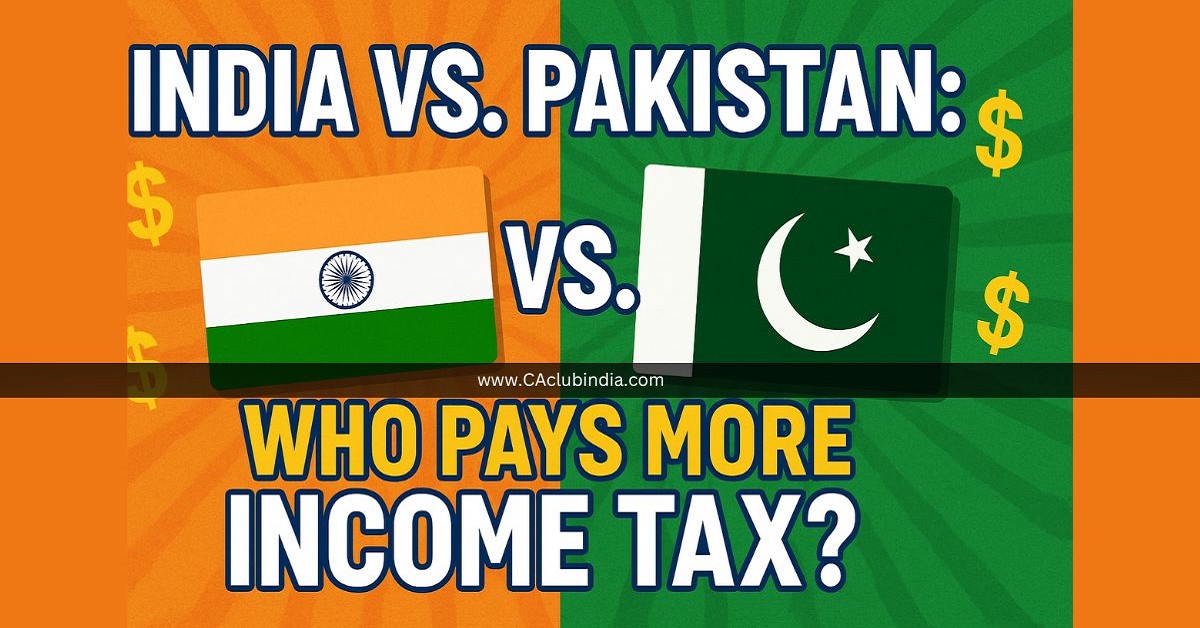India and Pakistan gained independence around the same time, yet their development paths have diverged significantly. As of 2024-25, India is the 5th largest economy in the world by nominal GDP, valued at approximately $4 trillion, and ranks 3rd globally by purchasing power parity (PPP) with a PPP GDP of over $14 trillion. In contrast, Pakistan ranks around 43rd-44th in the world by nominal GDP at approximately $340 billion, and about 24th by PPP, with a GDP of roughly $1.58 trillion.
India's GDP per capita (nominal) is around $2,850, while Pakistan's is approximately $1,500, indicating a significantly higher average income level in India. Moreover, India is growing at a much faster pace, with an estimated 6.5-7.2% growth rate, compared to Pakistan's slower 2-3% growth.
In regional terms, India is the largest economy in South Asia, while Pakistan ranks second but remains much smaller in scale.

India's Income Tax System (FY 2025-26)
India has adopted a dual income tax structure:
- Old Regime (with deductions & exemptions)
- New Regime (lower rates, fewer deductions - default choice from 2025)
New Regime Slabs (FY 2025-26)
| Income Slab | Tax Rate |
| Up to ₹4 lakh | 0% |
| ₹4 - ₹8 lakh | 5% |
| ₹8 - ₹12 lakh | 10% |
| ₹12 - ₹16 lakh | 15% |
| ₹16 - ₹20 lakh | 20% |
| ₹20 - ₹24 lakh | 25% |
| Above ₹24 lakh | 30% |
Standard deduction: ₹75,000
Tax rebate: Income up to ₹12 lakh effectively pays 0% tax
This makes India one of the most favorable countries for middle-income earners in terms of tax burden.
Pakistan's Income Tax System (FY 2024-25 Budget)
Pakistan recently unveiled a new budget amid IMF pressure to increase revenue. As part of this, the government proposed steep hikes in income tax, especially targeting the salaried class and non-filers.
Salaried Individual Slabs (PKR)
| Income Slab | Tax Rate |
| Up to PKR 600,000 | 0% |
| PKR 600,001 - 1.2 million | 5% |
| PKR 1.2 - 2.2 million | 15% |
| PKR 2.2 - 3.2 million | 25% |
| PKR 3.2 - 4.1 million | 30% |
| Above PKR 4.1 million | 35% |
- No standard deduction
- No significant rebates for middle-income earners
- Additional surcharge applies to high-net-worth individuals and AOPs (Associations of Persons)
Key Comparisons - India vs Pakistan Tax
| Criteria | India | Pakistan |
| Tax-free income | ₹12 lakh (with rebate) | ₹1.9 lakh (PKR 600,000) |
| Top tax rate | 30% | 35% |
| Standard deduction | ₹75,000 | None |
| Income threshold for highest slab | ₹24 lakh | ₹12.9 lakh (PKR 4.1m) |
| Ease for middle class | High | Low |
| Additional surcharges | Yes (old regime) | Yes (on non-filers/high earners) |
Why does the Indian Tax System stand Apart?
India has structured its tax policy to support consumption and growth, especially for salaried and middle-income earners.
Pakistan, under pressure from global lenders like the IMF, has raised tax rates aggressively to plug fiscal deficits.
India's economy is far more diversified and digitally integrated, helping boost tax compliance without overburdening individuals.
Who Pays More?
When it comes to income tax, India offers a significantly more favorable structure across most income levels. Low-income earners benefit more in India, thanks to a much higher tax-free threshold compared to Pakistan. Middle-income individuals in India enjoy complete tax exemption on income up to ₹12 lakh, which provides considerable relief to salaried professionals. On the other hand, high-income earners in Pakistan bear a heavier tax burden, with a top marginal rate of 35%, compared to India's 30% under the new regime.








 CAclubindia
CAclubindia
